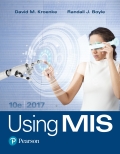
EBK USING MIS
10th Edition
ISBN: 8220103633635
Author: KROENKE
Publisher: YUZU
expand_more
expand_more
format_list_bulleted
Expert Solution & Answer
Chapter 8.8, Problem 8.6ARQ
Explanation of Solution
Enterprise social network (ESN):
- ESN is a software platform that uses social media (SM) to simplify cooperative work of people inside the organization.
- It uses specific enterprise social software designed to be used within the organization, instead of using other social media like Facebook, Twitter, and soon.
- ESN uses the traditional SM including status updates about the organization, blogs, image and video sharing, microblogs, wikis and personal sites.
Primary goal of an ESN:
The primary goal of an ESN is as follows:
- Improve communication
- Knowledge sharing
- Collaboration
- Decision making
- Problem solving
Web 2.0:
In the Internet world Web 2.0 is a second stage of development and it is characterized particularly by the change from static to dynamic web pages or growth of social media (SM) and user-generated content.
Enterprise 2.0:
The emergent social software platforms inside the companies are called as Enterprise 2.0. It uses the concept of Web 2.0 technologies such as ratings, tagging, RSS, sharing, and networking in the context of the enterprise.
SLATES model:
SLATES model was defined by McAfee and the acronym for SLATES is as follows:
- S – Search
- The first characteristic is “Search”; the employees want to be able to search for content within the organization. The employees find that search in more effective way than directing content structures like tables and list of content.
- L – Links
- The second characteristic is “Link” here the people access the organization link in Web as the same way the employees access the organizational content through links.
- A – Authoring
- The third one is “Authoring” and here the employees also want to author organizational content using wikis, blogs, discussion groups etc.
- T – Tags
- The fourth characteristic is “Tags”, these tags are organize into structures like as it done on the Web.
- E – Extensions
- In extensions, the employees need applications that allow them to rate tagged content and to use the tags to expect content that will be interest to the employees.
- S – Signals
- Pushing enterprise content to users based on alerts and subscriptions.
Changes in organizations communicate with employees:
- Communication channels inside corporations have changed in equally affected way...
Expert Solution & Answer
Want to see the full answer?
Check out a sample textbook solution
Students have asked these similar questions
Create 6 users: Don, Liz, Shamir, Jose, Kate, and Sal.
Create 2 groups: marketing and research.
Add Shamir, Jose, and Kate to the marketing group.
Add Don, Liz, and Sal to the research group.
Create a shared directory for each group.
Create two files to put into each directory:
spreadsheetJanuary.txt
meetingNotes.txt
Assign access permissions to the directories:
Groups should have Read+Write access
Leave owner permissions as they are
“Everyone else” should not have any access
Submit for grade:
Screenshot of /etc/passwd contents showing your new users
Screenshot of /etc/group contents showing new groups with their members
Screenshot of shared directories you created with files and permissions
⚫ your circuit diagrams for your basic bricks, such as AND, OR, XOR gates and 1 bit multiplexers,
⚫ your circuit diagrams for your extended full adder, designed in Section 1 and
⚫ your circuit diagrams for your 8-bit arithmetical-logical unit, designed in Section 2.
1 An Extended Full Adder
In this Section, we are going to design an extended full adder circuit (EFA). That EFA takes 6 one bit inputs: aj, bj,
Cin, Tin, t₁ and to. Depending on the four possible combinations of values on t₁ and to, the EFA produces 3 one bit
outputs: sj, Cout and rout.
The EFA can be specified in principle by a truth table with 26 = 64 entries and 3 outputs. However, as the EFA
ignores certain inputs in certain cases, it is easier to work with the following overview specification, depending only
on t₁ and to in the first place:
t₁ to Description
00
Output Relationship
Ignored
Inputs
Addition Mode
2 Coutsjaj + bj + Cin, Tout= 0
Tin
0 1
Shift Left Mode
Sj = Cin,
Cout=bj, rout = 0
rin, aj
10
1 1
Shift Right…
Show the correct stereochemistry
when needed!!
mechanism:
mechanism:
Show the correct stereochemistry when needed!!
Br
NaOPh
diethyl ether
substitution
Chapter 8 Solutions
EBK USING MIS
Ch. 8.3 - Prob. 1EGFQCh. 8.3 - Prob. 2EGFQCh. 8.3 - Prob. 3EGFQCh. 8.3 - Prob. 4EGFQCh. 8.4 - Prob. 1EGDQCh. 8.4 - Prob. 2EGDQCh. 8.4 - Prob. 3EGDQCh. 8.4 - Prob. 4EGDQCh. 8.4 - Prob. 5EGDQCh. 8.8 - Prob. 1SGDQ
Ch. 8.8 - Prob. 2SGDQCh. 8.8 - Prob. 3SGDQCh. 8.8 - Prob. 4SGDQCh. 8.8 - Prob. 8.1ARQCh. 8.8 - Prob. 8.2ARQCh. 8.8 - Prob. 8.3ARQCh. 8.8 - Prob. 8.4ARQCh. 8.8 - Prob. 8.5ARQCh. 8.8 - Prob. 8.6ARQCh. 8.8 - Prob. 8.7ARQCh. 8.8 - Prob. 8.8ARQCh. 8 - Prob. 8.1UYKCh. 8 - Prob. 8.2UYKCh. 8 - Prob. 8.3UYKCh. 8 - Prob. 8.4UYKCh. 8 - Prob. 8.5UYKCh. 8 - Prob. 8.6CE8Ch. 8 - Prob. 8.7CE8Ch. 8 - Prob. 8.1CS8Ch. 8 - Prob. 8.11CS8Ch. 8 - Prob. 8.12CS8Ch. 8 - Prob. 8.13CS8Ch. 8 - Prob. 8.14CS8Ch. 8 - Prob. 8.15CS8Ch. 8 - Using your answers to these questions, write a job...Ch. 8 - Prob. 8.17CS8Ch. 8 - Prob. 8.18MMLCh. 8 - Prob. 8.19MML
Knowledge Booster
Similar questions
- In javaarrow_forwardKeanPerson #keanld:int #keanEmail:String #firstName:String #lastName: String KeanAlumni -yearOfGraduation: int - employmentStatus: String + KeanPerson() + KeanPerson(keanld: int, keanEmail: String, firstName: String, lastName: String) + getKeanld(): int + getKeanEmail(): String +getFirstName(): String + getLastName(): String + setFirstName(firstName: String): void + setLastName(lastName: String): void +toString(): String +getParkingRate(): double + KeanAlumni() + KeanAlumni(keanld: int, keanEmail: String, firstName: String, lastName: String, yearOfGraduation: int, employmentStatus: String) +getYearOfGraduation(): int + setYearOfGraduation(yearOfGraduation: int): void +toString(): String +getParkingRate(): double In this question, write Java code to Create and Test the superclass: Abstract KeanPerson and a subclass of the KeanPerson: KeanAlumni. Task 1: Implement Abstract Class KeanPerson using UML (10 points) • Four data fields • Two constructors (1 default and 1 constructor with all…arrow_forwardPlz correct answer by best experts...??arrow_forward
- Q3) using the following image matrix a- b- 12345 6 7 8 9 10 11 12 13 14 15 1617181920 21 22 23 24 25 Using direct chaotic one dimension method to convert the plain text to stego text (hello ahmed)? Using direct chaotic two-dimension method to convert the plain text to stego text?arrow_forward: The Multithreaded Cook In this lab, we'll practice multithreading. Using Semaphores for synchronization, implement a multithreaded cook that performs the following recipe, with each task being contained in a single Thread: 1. Task 1: Cut onions. a. Waits for none. b. Signals Task 4 2. Task 2: Mince meat. a. Waits for none b. Signals Task 4 3. Task 3: Slice aubergines. a. Waits for none b. Signals Task 6 4. Task 4: Make sauce. a. Waits for Task 1, and 2 b. Signals Task 6 5. Task 5: Finished Bechamel. a. Waits for none b. Signals Task 7 6. Task 6: Layout the layers. a. Waits for Task 3, and 4 b. Signals Task 7 7. Task 7: Put Bechamel and Cheese. a. Waits for Task 5, and 6 b. Signals Task 9 8. Task 8: Turn on oven. a. Waits for none b. Signals Task 9 9. Task 9: Cook. a. Waits for Task 7, and 8 b. Signals none At the start of each task (once all Semaphores have been acquired), print out a string of the task you are starting, sleep for 2-11 seconds, then print out a string saying that you…arrow_forwardProgramming Problems 9.28 Assume that a system has a 32-bit virtual address with a 4-KB page size. Write a C program that is passed a virtual address (in decimal) on the command line and have it output the page number and offset for the given address. As an example, your program would run as follows: ./addresses 19986 Your program would output: The address 19986 contains: page number = 4 offset = 3602 Writing this program will require using the appropriate data type to store 32 bits. We encourage you to use unsigned data types as well. Programming Projects Contiguous Memory Allocation In Section 9.2, we presented different algorithms for contiguous memory allo- cation. This project will involve managing a contiguous region of memory of size MAX where addresses may range from 0 ... MAX - 1. Your program must respond to four different requests: 1. Request for a contiguous block of memory 2. Release of a contiguous block of memory 3. Compact unused holes of memory into one single block 4.…arrow_forward
- using r languagearrow_forwardProgramming Problems 9.28 Assume that a system has a 32-bit virtual address with a 4-KB page size. Write a C program that is passed a virtual address (in decimal) on the command line and have it output the page number and offset for the given address. As an example, your program would run as follows: ./addresses 19986 Your program would output: The address 19986 contains: page number = 4 offset = 3602 Writing this program will require using the appropriate data type to store 32 bits. We encourage you to use unsigned data types as well. Programming Projects Contiguous Memory Allocation In Section 9.2, we presented different algorithms for contiguous memory allo- cation. This project will involve managing a contiguous region of memory of size MAX where addresses may range from 0 ... MAX - 1. Your program must respond to four different requests: 1. Request for a contiguous block of memory 2. Release of a contiguous block of memory 3. Compact unused holes of memory into one single block 4.…arrow_forwardusing r languagearrow_forward
- Write a function to compute a Monte Carlo estimate of the Beta(3, 3) cdf, and use the function to estimate F(x) for x = 0.1,0.2,...,0.9. Compare the estimates with the values returned by the pbeta function in R.arrow_forwardWrite a function to compute a Monte Carlo estimate of the Gamma(r = 3, λ = 2) cdf, and use the function to estimate F(x) for x = 0.2, 0.4, . . . , 2.0. Compare the estimates with the values returned by the pgamma function in R.arrow_forwardusing r languagearrow_forward
arrow_back_ios
SEE MORE QUESTIONS
arrow_forward_ios
Recommended textbooks for you
 Principles of Information Systems (MindTap Course...Computer ScienceISBN:9781285867168Author:Ralph Stair, George ReynoldsPublisher:Cengage Learning
Principles of Information Systems (MindTap Course...Computer ScienceISBN:9781285867168Author:Ralph Stair, George ReynoldsPublisher:Cengage Learning Fundamentals of Information SystemsComputer ScienceISBN:9781337097536Author:Ralph Stair, George ReynoldsPublisher:Cengage Learning
Fundamentals of Information SystemsComputer ScienceISBN:9781337097536Author:Ralph Stair, George ReynoldsPublisher:Cengage Learning Information Technology Project ManagementComputer ScienceISBN:9781337101356Author:Kathy SchwalbePublisher:Cengage Learning
Information Technology Project ManagementComputer ScienceISBN:9781337101356Author:Kathy SchwalbePublisher:Cengage Learning Fundamentals of Information SystemsComputer ScienceISBN:9781305082168Author:Ralph Stair, George ReynoldsPublisher:Cengage Learning
Fundamentals of Information SystemsComputer ScienceISBN:9781305082168Author:Ralph Stair, George ReynoldsPublisher:Cengage Learning Principles of Information Systems (MindTap Course...Computer ScienceISBN:9781305971776Author:Ralph Stair, George ReynoldsPublisher:Cengage Learning
Principles of Information Systems (MindTap Course...Computer ScienceISBN:9781305971776Author:Ralph Stair, George ReynoldsPublisher:Cengage Learning


Principles of Information Systems (MindTap Course...
Computer Science
ISBN:9781285867168
Author:Ralph Stair, George Reynolds
Publisher:Cengage Learning

Fundamentals of Information Systems
Computer Science
ISBN:9781337097536
Author:Ralph Stair, George Reynolds
Publisher:Cengage Learning

Information Technology Project Management
Computer Science
ISBN:9781337101356
Author:Kathy Schwalbe
Publisher:Cengage Learning

Fundamentals of Information Systems
Computer Science
ISBN:9781305082168
Author:Ralph Stair, George Reynolds
Publisher:Cengage Learning

Principles of Information Systems (MindTap Course...
Computer Science
ISBN:9781305971776
Author:Ralph Stair, George Reynolds
Publisher:Cengage Learning